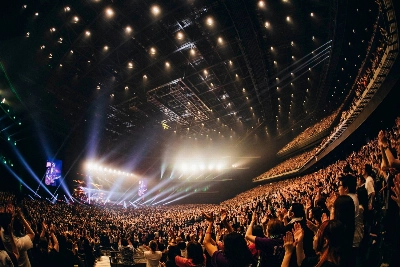As England was once called a nation of shopkeepers, Japan could be called a nation of readers.
Accordingly, at coffee shops and ramen shops you'll often find magazines and comic books provided for patrons. Walk into any convenience store, at almost any hour of the day or night, and you're bound to see a magazine browser or three, all standing and reading in a row. Even on tightly packed rush-hour trains, valiant readers hold books mere centimeters away from their noses, while their neighbors surreptitiously read over their shoulders.
In this readers' paradise, there are dozens of places where you can while away the hours reading . . . for absolutely free.
On first glance, Junkudo looks more like a hotel lobby than a bookstore. What first attracts the eye is a long wooden counter, behind which clerks quietly stand equidistant apart. Books are respectfully displayed like artwork.
Renovations at the Tokyo branch of the Kansai-based bookstore giant were completed last month. The nine-story megastore, which claims to be the largest in Japan, stocks 1.5 million books, including about 50,000 foreign-language books, newspapers and magazines on the top floor.
Unlike most Japanese bookstores, Junkudo displays best sellers and recommendations on 2-meter-high shelves and organizes them according to field and topic. On each floor, customers can sit and browse at tables situated along the aisles.
Taking this approach one step further is Books & Cafe, the bookstore in Daimaru department store near JR Tokyo Station. As the name states, customers can enjoy freshly brewed coffee while browsing the stock of 150,000 titles (although magazines can't be taken into the cafe).
"Following customer requests, we enlarged the coffee shop space last year. With good coffee and a quiet atmosphere, the shop provides a relaxing space for adults," says Hiroaki Sakamoto, a department store spokesman.
Naturally, Books & Cafe was also designed to entice potential book buyers, but browsing here is free and easy (though the coffee will cost you), and its location near Tokyo Station makes it a great spot for commuters and travelers.
Like bookstores, libraries are another kind of oasis in the big city.
Among hundreds in Tokyo, there are some specialty libraries that remain less-known to the public, offering a quiet, spacious and comfortable environment for studying, reading or just relaxing.
One is the Ozone Information Bank Library in the Shinjuku Park Tower building. A facility of the Living Design Center, a Tokyo Gas Co. affiliate, this reference library focuses on architecture and interior design. Its selection includes 100 foreign magazines and various foreign books on interior design. Nearly 30 percent of the library's 17,000 titles are from overseas. In addition, the center has coffee shops and showrooms displaying various interiors.
Ueno's International Library of Children's Literature can be enjoyed by both children and adults. Though the main wing of the building is still under construction, there is a cozy reading area on the fourth floor welcoming children and picture-book lovers with 3,000 books from around the world.
Visitors age 18 and over can also use the second-floor study room, where 40,000 Japanese and foreign children's books and related documents are available.
Foreign children's books are arranged according to country, and books that have been recognized with book awards are given special displays.
Though a little cramped, Tabino Toshokan, or the Library of Tourism and Culture, houses 25,000 travel-related items collected by JTB Corp., Japan's leading travel agency. Four bookshelves are devoted to various English guidebooks, including the Lonely Planet and Macmillan Travel series. There are also dozens of in-flight magazines.
With its extensive collection of periodicals, the World Magazine Gallery in Ginza never fails to impress first-time visitors. Organized by leading publisher Magazine House, the gallery displays 900 magazine titles from 55 countries in the company's lobby.
Items are arranged according to continent, country and sometimes by subject. Visitors are free to read their selections at nearby tables or take them to Mag-Table, a coffee shop on the second floor.
Many museums also offer spacious and quiet reading areas accessible to anybody for free.
The Tokyo National Museum contains the Research and Information Center. Although you have to fill in the forms twice (at the side gate and at the reception counter) just to enter, and most of the center is taken up by cabinets containing photographs of the museum's collection, it's worth a visit.
The center was designed for scholarly use, but art lovers will find plenty to enjoy among the coffee-table art books of Japanese masterpieces and art catalogs of the museum's past exhibitions.
The seventh-floor reading room of the Edo Tokyo Museum in Ryogoku has quite a view, but the real gem is hidden in the basement: a spacious video library that has 28 private booths equipped with a bench and video deck, where you can watch one of 200 films on the history and culture of Tokyo. A dozen of the films are in English.
Other museums such as the National Museum of Modern Art Film Center, the Tokyo Metropolitan Museum of Photography and the Museum of Contemporary Art also have reading rooms and libraries with extensive collections.
















With your current subscription plan you can comment on stories. However, before writing your first comment, please create a display name in the Profile section of your subscriber account page.